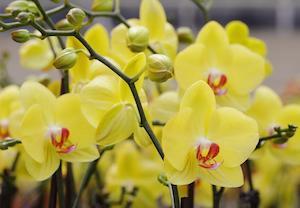
The vibrant colors of orchid blooms can quickly brighten up any space, which begs the question: Who would want to enjoy an orchid for just one season?
Though caring for your Phalaenopsis orchid is simple, adding another easy step—fertilizing—to your care routine can help give your orchid an extra boost, allowing it to supply you with beautiful blooms for years to come.
Just like humans, orchids need rest, too. And it’s during this resting phase your orchid gets the nutrients it needs to provide you with colorful flowers. Think of the resting phase as your nightly rest (although for an orchid, it’s more like a hibernation), and think of the fertilization process the same way you would view taking a vitamin — it’s not necessary for your health, but it can give you a boost if you need it.
Fertilizing your orchid isn’t the same as fertilizing your lawn, though.
Like watering your orchid, fertilizing it isn’t complicated. In fact, it’s easy t set up a fertilizing schedule to give your blooms an extra boost of nutrients. Here are a few tips to follow for establishing the when, why and how of orchid fertilization.
Fertilize once the last bloom has fallen off your orchid. While your orchid is resting, aim to fertilize it at least once a month and at most every other week. You don’t need to water on the weeks you fertilize. You can fertilize your orchid while it’s in bloom, but it’s really not necessary. Performing this step during the resting phase helps give your orchid extra nutrients for reblooming.
Orchids thrive in a tropical environment, which, let’s face it, most homes are not. Fertilizing your orchid not only gives it an extra energy boost for reblooming, it provides it with additional nutrients it would normally receive in its native habitat. Adding fertilizing to your care routine helps replenish the nutrients in your potting media, too.
If you can’t find a fertilizer specially formulated for orchids, choose all-purpose flower fertilizer that has nitrogen, phosphorus and potassium. You’ll want to dilute the fertilizer by half by mixing it with water. Then apply it using a watering can with a narrow spout.
Fertilizing your orchid can be easily added to your watering schedule to keep your blooms healthy and vibrant. For more detailed instructions to fertilization, how to select the right fertilizer and more, download our free guide on orchid fertilization.

Copyright Just Add Ice® Orchids 2023